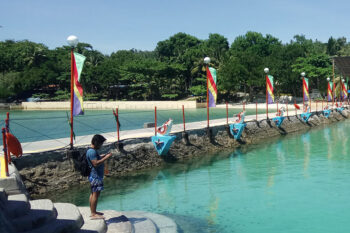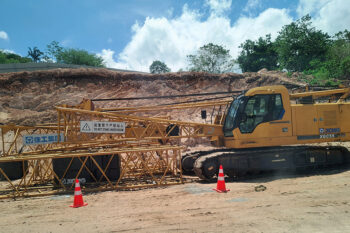I bombed Sulu every night.
My engine sang into the lush, blue sky.
I didn’t know if they would live or die.
I bombed Sulu every night.
Red mangroves bursting down below us,
Those people didn’t even know us.
Following the loss of life of a foreign hostage on the island of Jolo in the Sulu Archipelago, President Rodrigo Duterte announced to use air assets which had not been used before due to the danger of collateral damage inflicted on the communities spread out in the jungles of Sulu and the neighbouring island Basilan.
This statement came directly after an apology to the German people after the beheading. Whilst for a long time Digong has been an advocate for independence and a proud stance vis-à-vis the external patrons of the Philippines, the excuse is a morally decent thing to do. In a way, the President claimed the mistakes of a very bad behaved child – the bandits and zealots of the Abu Sayyaf group – as his own, and acknowledged the failure of the military to rescue the old man. For a persona with an inherent machismo, persona of strength and aggressive masculinity such as Digong it was maybe not an easy step to make. However, whether he acted on the advice of his close advisory circle or spoke out what every farsighted statesman might have said elsewhere, his words were appropriate and stood in contrast to the raunchy and loud cowboy people perceive to be the President’s ultimate self.
Problematic is his and the cabinet’s quest or wish for revenge, or rather punishment. Dropping bombs on forests and rocks across the Southern Philippine has never been particularly successful in eradicating the scourge of piracy, insurgency, crime and terrorism. Although the craters of mortars have become part of the landscape just as much a rice cooker or hammocks are part of houses, they are still something “normally abnormal”, a permanent mark of an enduring state of exception. The ongoing cartography of violence in Mindanao and Sulu leaves questions for our maps of the future. By employing cyclical and endless violence the decision-makers in Manila opt for using instruments of power, not resolving the root-causes of the whole mess.
Pundits and policymakers tend to agree that these days the Abu Sayyaf Group (ASG) has morphed into an outfit of organized crime, with ideology being accordingly a fashionable pretense of generating financial support rather than serving as a genuine expression of another revival of struggle. However, to reduce the Abu Sayyaf to a bunch of gangsters is tempting but it leaves out a part of the picture. The group is a complex and shapeless mechanism which is based on community-anchored networks rooted in neglected and exploited barangays. The life and death of a teenage ASG bandit is less glorious than the screens from Malacañang are showing. In the end, even he is subject to “Isang kahig, isang tuka” in the extreme form; a hand-to-mouth existence based on robbery and violence to secure his daily bread. In addition to that, political violence bred by the visible and invisible gangsters of Sulu emerges where genuine power of the state is lacking. Insecurity, fear and penchants for domination marks the oppressed and oppressors alike, like the philosopher Hannah Arendt pointed out. What goes on in the mind of the executioner who slowly cut through the neck of Mr Kantner?
Any news on the ASG, its actions or affiliates – along with the state’s response – is cyclical in nature and empty in genuine content. The campaign against these outlaws reminds one of a vicious hide-and-seek game which gets reloaded every now and then. The Al-Barka incidents of 2007 and 2011 and the battle in Baguindan, Tipo-Tipo had caused dozens of casualties on the side of the government. Brave soldiers from around the country, more than ten alone in the last months, are giving their lives for a struggle which doesn’t seem to end. The last clash occurred in Patikul just a few days ago with reportedly 17 soldiers wounded. Yet, every time a big clash with the bandits occurs, life gets back to normal after a week or two. The exceptional state of warpeace on Sulu and Basilan continues, permutates and reverses back until static prevails.
In the campaign against such group as the ASG, to kill a leader is tantamount to remove one head of the Hydra, a mythical creature with many heads who would automatically grow back after they’ve been slaughtered.
In the myth the monster was killed by scorching the neck with fire so that nothing could grow. Granted, the solution seems practical for the purpose of counter-insurgency. Scorched earth and search/destroy are all concepts familiar to students of warfare. But they had hardly resulted in long-term pacification and bred actually only the new generation of insurgents and guerrillas. A case in point was the 2nd February 2012 drone attack on the location of alleged terrorists in Parang, Sulu; the most far-west municipality at the coast of Jolo island, adjacent to Indanan where the German sailor was executed. This sound of fury was so far the only documented strike of such kind to Sulu or Basilan although drones are usually buzzing at the sky of Zamboanga City, a coastal town across Basilan Island. One can only fathom the nightmare which could befall Sulu and the Tausug people if technology such as drones or even other air-assets, with their ominous echo of sonic and extensive warfare was used. A war without end.
One researcher who stayed from 1966 to 1968 in Tubig Nangka, a community in Eastern Jolo described the basic dilemma of the government rather vividly with the following words: “A massive military operation on Jolo simply cannot work, for unless the government wishes to commit itself to a permanent garrison of tens of thousands of men, sooner or later the soldiers must leave and the situation will return to the way it was before. The government attempted a massive military operation in eastern Jolo in the early 1950s against an ‘outlaw’ named Kamlun, and in certain regions almost all men of fighting age were killed. Their children are now grown men lacking mature adult leadership (…) and a potentially explosive situation was brewing in this area. The ideas men have about law and justice cannot be eliminated by force without destroying the entire society.” (Thomas Kiefer, The Tausug)
The semblance of an enforced peace led by the military or the police against the convenient rebel-turned-criminals appears now at best as temporary only and at worst as an exercise in futility. As multi-faceted and complex the ASG is, as diverse the response has to be as well. Truth in the conflict areas of Mindanao is based in scarcity. Ghosts can take the form of eerie spectres (“ISIS/Daesh”) or shadows coming from within our own movements (home-grown institutions and various tentacles). Tackling the ASG means asking sometimes uncomfortable questions about relationships, institutions, local-national interplays, and finally all things political.
Going back to the classics, it was Dr. Najeeb Saleeby who gave this summary account of the Spanish efforts to control Sulu: “…a cruel inhuman strife marked with an astounding profuseness of bloodshed and terrible loss of life and evil of all sorts, was prolonged for the space of three hundred and twenty years without any advantage that is worth considering.” (Najeeb Saleeby, A History of Sulu). The irony of the story is that the vices left by the colonial masters have slowly become of the political culture in Sulu itself – as in other localities in the Philippines, too.
Someone dear to me had once visited Lake Sebu, a slightly hidden but beautiful municipality in the province of South Cotabato, Mindanao, which was still rooted in tradition as much as simply in a different terrain than Luzon or Visayas. “The periphery” lives and breathes and the first step is to cease to call it periphery. It’s not enough that President Duterte is from Davao and has Moro ancestry; it is rather about genuine empathy for the injustices of the past translated into a proper action and policy steps for the present and future. There’s simply no space for scalawags, bombings and all-out campaigns in such a beautiful place as Mindanao and the Sulu Archipelago. What the Philippines rather need is a sense of shared destiny.
(MindaViews is the opinion section of MindaNews. PeaceTalk is open to anyone who wishes to share his/her views on peace in Mindanao. Hasan T. Laponte is the pen name of a development worker who has been working with community organizations in Mindanao and Philippines for a few years and who is based part-time in Manila)







